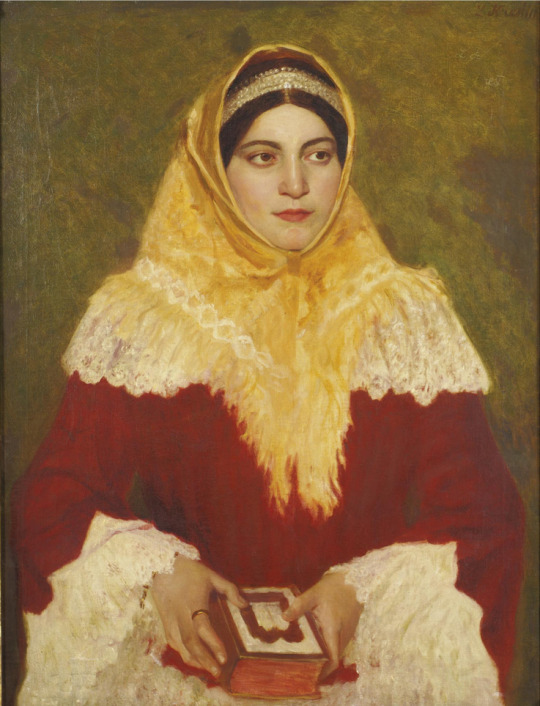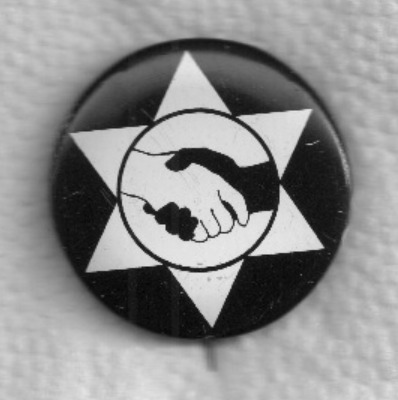Text






411 notes
·
View notes
Text

This 2,500-year-old potsherd (c. 475 BC) contains one of the earliest known references to the Jewish festival of Passover.
The Aramaic note from the Island of Elephantine, Egypt, reads: "To Hoshaya. Greetings! Take care of the children until Ahutab gets there. Don't trust anyone else with them! If the flour for your bread has been ground, make a small portion of dough to last until their mother gets there. Let me know when you will be celebrating Pascha (Passover). Tell me how the baby is doing!"
Passover commemorates the liberation of the Israelites from Egypt and is observed annually by Jewish people all over the world. This year, Passover begins at sundown on 12 April and ends the evening of 20 April. via Ashmolean Museum
979 notes
·
View notes
Text


Jewish child's amulet from Ukraine, ca. 1800,
Such amulets were meant to be worn around the neck on a string or chain. It is likely that the first born boy would wear it if the pidyon haben ceremony couldn't be performed on time (during the pidyon haben ceremony, it's a custom to cover the baby with gold jewelry for good luck). The back of the amulet says: "Save this baby of the tribe of Israel from the evil eye. Raise it to your Torah and protect it with your mercy, Amen"
#jewish#ukraine#superstition and mysticism#jewish history#judaica#jewish amulet#askenazi amulet#ashkenazi judaica
810 notes
·
View notes
Photo

Portrait of a Jewish woman holding a siddur, Lazar Krestin (1868-1938), Polish
1K notes
·
View notes
Text

medieval jewish amulet texts from the sefer raziel. the top, "for grace and favor." the bottom, "to safeguard a man against all weapons."
634 notes
·
View notes
Text

Purim wall decoration in Hebrew and Yiddish belonging to the Ashkenazi community of Jerusalem, mid-19th century
236 notes
·
View notes
Text

A Cheder teacher known as “Binyomin Hersh the Beard,” Biała Bielec, Poland, 1920s. “The longest beard in Biała, which students have more than once nailed to the table while he dozes off. That’s why he has such wonderful, sad eyes.”
343 notes
·
View notes
Text
Being a Jew in America right now is so bizarre. The president's right hand man endorses a far-right German party that wants to remove Holocaust memorials and ban the sale of kosher meat, members of the ruling party are doing nazi salutes at rallies, and standing members of congress openly repeat conspiracy theories about the Rothschilds and Jewish space lasers. Then you see a news article about antisemitism and it's like "we need to do something about all these college students protesting mass killings."
19K notes
·
View notes
Text



vintage jewish buttons - x
758 notes
·
View notes
Text

Jewish amulet bearing the name of god, Shadai, from Iraq, c. 1935
1K notes
·
View notes
Text






jewish vintage social justice buttons - x
2K notes
·
View notes
Note
Do you have any book recommendations for secular Jews? I feel really disconnected from my culture/racial identity/other Jews, but I’m not religious beyond cherishing the practices of our tradition, if that makes sense.
hmm.. i personally think that there can be no difference drawn between the culture, ethnicity, and religion of judaism. so, i don't see how a book about jewish culture could be written without reference to religion. i haven't read or encountered such books. but as a deeply religious person i haven't sought them out, so maybe others who see this can give suggestions. however, i'll try and provide some that might be what you're looking for (also quite a few of these are available on the internet archive)! i will be posting a more extensive reading list later on, so keep an eye out for that if you'd like. books marked with an asterisk are endorsed by the rabbinical council of america.
if you are completely disconnected, i can recommend these introductory books:
TORAH!!! (half-joking)
To Be a Jew: A Guide to Jewish Observance In Contemporary Life* by Rabbi Hayim Donin (my top recommendation)
Jewish Literacy: The Most Important Things to Know About the Jewish Religion, Its People, and Its History by Rabbi Joseph Telushkin (also crazy good)
Essential Judaism: A Complete Guide to Beliefs, Customs & Rituals by George Robinson (like 600 pages and textbook-like but this means that there are very thick sections on what could be described as the secular stuff)
Living a Jewish Life by Anita Diamant ("descriptive rather than prescriptive," quite liberal and a light read)
here's some stuff on specific religious subjects that may help you simply learn, whether or not you engage with the practices:
Waters of Eden: The Mystery of the Mikveh* by Rabbi Aryeh Kaplan (a mikveh should be built before a synagogue in a community which has neither, so i think jews should learn about them even if they will never use one)
The Jewish Way in Death and Mourning* & The Jewish Way in Love and Marriage* by Rabbi Maurice Lamm
Shabbos: Tasting Eternity* by Rabbi Daniel Travis
i think folklore is super important for more jews to learn about as it often reflects the collective psychology of what we were going through at the time. it's why i think it should be read/understood alongside general jewish history. i'll probably devote a separate post to info on folklore later. food and diaspora all mixed in here too:
People Love Dead Jews by Dara Horn
A History of Judaism by Martin Goodman
The Story of the Jews: Finding the Words by Simon Schama
The Book of Jewish Food: An Odyssey from Samarkand to New York by Claudia Roden
Divination, Magic, and Healing: The Book of Jewish Folklore by Rabbi Ronald Isaacs
Miriam's Tambourine: Jewish Folktales from Around the World by Howard Schwartz
okay, i think i've given a good outline. i mostly read religious-specific books so my strictly historical/food-centered recs are sparse, i apologize. it's also been forever since i've read many of these so they may have issues i don't fully remember. check on the replies/reblogs for any info about that or general corrections. i hope these helped! if i misinterpreted your ask, you can always come back to my inbox.
159 notes
·
View notes
Text

Jewish amulet for a married couple with an inscription in Judeo-Persian, Iran, ca. 1900
1K notes
·
View notes
Text

Painted wooden chest with Hebrew inscriptions, Eastern Europe, late 19th century AD. Private Collection.
This wooden chest features decorative floral motifs, stylized birds, and a central Star of David panel with Hebrew lettering. The surface is adorned with multicolored floral designs, metal studs along the edges, and raised footed supports at the base. The craftsmanship involves detailed paintwork and ornamental details typical of folk art from Eastern European Jewish communities.
940 notes
·
View notes
Text
Re: green colonialism
When Zionists talk about Israel making the desert bloom, they are using the most insidious language to describe Israel’s ecocide of Palestinian ecosystems and biome, which is an often overlooked casualty of colonial violence.
One of the worst perpetrators of this ongoing ecocide is the Jewish National Fund (JNF), an Israeli organisation that disguises itself as an environmental NGO yet owns around 13% of the occupied land in Palestine (which I’ll bring up a lot below). The JNF can be considered the main reason Zionists love to brag about the number of tress and forests that they have planted in Palestine, while skipping over the part that addresses what trees, where they are planted, and why they're planted in the specific areas.
As for what kind of trees, the JNF planted vast swaths of non-native trees, mainly pine and eucalyptus trees, in place of indigenous arboreta. Both trees are invasive species; pine is not indigenous to the land, and therefore it is not a sustainable plant. Pines planted by Israel often fail to adapt to the soil which requires replanting them over and over again. Additionally, they require huge amounts of water, which in turn affects water systems and aquifers around them. On top of that, the acidic pine needles that the tree sheds tend to destroy all surrounding small plants, gravely affecting the livelihood of Palestinian shepherds whose animals depend on grazing the land. Lastly, and not to forget, that these invasive plants are more prone to fires. As Palestinian scholar Ghada Sasa put it, zionists have "converted Palestine into a tinder box" over the past century, which was evident in 2010’s Mount Carmel wildfire, which was the worst in Israel’s history. Ironically, this fire revealed underneath it agricultural terraces constructed by Palestinian farmers, which were purposely obscured by Israel when constructing the park.
With that, and as for where these forests are stationed, they are often built on top of the ruins of depopulated Palestinian villages. Take for example Birya Forest, Israel's largest man-made forest in the north, and was strategically planted over the ruins of six different Palestinian villages, one of which was 'Ayn Zaytoun (meaning spring of olives), a farming village that used to home 1,000 Palestinians, who were ethnically cleansed by Israel to make way for this forest. Other examples include the Canada Park or Carmel National Park. In places like the Jerusalem Botanical Gardens, the ruins of demolished Palestinian homes can be spotted among the pine trees, and in this particular case, it’s the ruins of the village of Ajour.
Finally, the reason why the JNF seems to be fixated on pine trees for example is primarily because to them, pine trees help evoke an imagery of European wilderness, and this is evident with Jewish settlers nicknaming the Carmel National Park "little Switzerland", despite it being partially built on top of the ruins of the Palestinian village of al-Tira. Additionally, pine trees grow fast, which works in Israel’s favour to attempt to accelerate the erasure of Palestinian history and memory. The JNF usually distributes pine saplings to settlers to plant annually, and they understand that while these cost nothing, yet, in their own words, there will make a forest in 10 years’ time.
This is all scratching at the surface of Israel’s green colonialism and ecocide in Palestine, and I should probably make another post to talk about Israel’s deliberate destruction of Palestinian farmland and crops to build its Jewish-only roads and separation apartheid wall, or how it pays tax incentives to Israeli companies with the highest polluting rates to move to the West Bank, or how they drained the oldest documented lake in history despite scientist warnings, or the continued destruction of olive trees (about one million) by the state of Israel and its violent settlers. But in any case, at this point no one can buy into Israel’s green-washing of its genocide, especially after seeing what they had done to Gaza’s lands, particularly fertile lands.
Simply put, Zionism has employed every method at its disposal to try to erase Palestinians and their history, including planting trees.
2K notes
·
View notes
Text


necklace depicting three figures found in an amulet of protection against lilit from the sefer raziel.
3K notes
·
View notes
